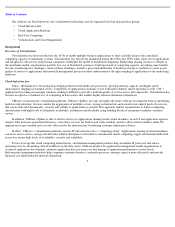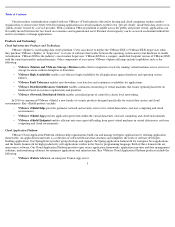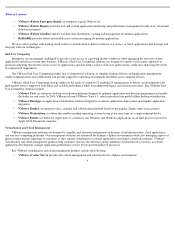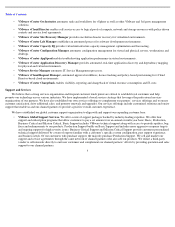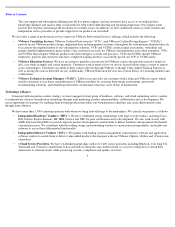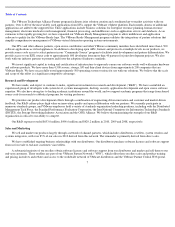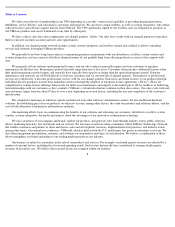VMware 2010 Annual Report Download - page 15
Download and view the complete annual report
Please find page 15 of the 2010 VMware annual report below. You can navigate through the pages in the report by either clicking on the pages listed below, or by using the keyword search tool below to find specific information within the annual report.
Table of Contents
software-as-a-service, or “SaaS”. Our success depends on organizations and customers perceiving technological and operational benefits and
cost savings associated with the increasing adoption of virtual infrastructure solutions for on-premises data centers as well as for cloud
computing and end-user computing. Although the use of virtualization technologies on servers and in on-premises data centers has gained
acceptance for enterprise-level applications, the extent to which adoption of virtualization for cloud computing and end-user computing remains
uncertain. As the markets for our products mature and the scale of our business increases, the rate of growth in our product sales will likely be
lower than those we have experienced in earlier periods. In addition, to the extent that virtualization infrastructure solutions are adopted more
slowly or less comprehensively than we expect, our revenue growth rates may slow materially or our revenue may decline substantially.
We expect to face increasing competition that could result in a loss of customers, reduced revenues or decreased operating margins.
The cloud computing, virtualization and end-user markets are inter-
related and rapidly evolving, and we expect competition to significantly
intensify in the future. For example, Microsoft continues to make incremental improvements to its virtual infrastructure and virtual management
products. Microsoft also has cloud-
based computing offerings. We also face competition from other companies that have announced a number of
new product initiatives, alliances and consolidation efforts. For example, Citrix Systems continues to enhance its end-user and server
virtualization offerings and now has a client hypervisor in the market. IBM, Google and Amazon have announced new cloud computing
initiatives. Red Hat has also released commercial versions of Linux that have virtualization capabilities as part of the Linux kernel (“KVM”).
Other companies have also indicated their intention to expand offerings of virtual management and cloud computing solutions.
We believe that the key competitive factors in the virtualization and cloud computing markets include:
Existing and future competitors may introduce products in the same markets we serve or intend to serve, and competing products may have
better performance, lower prices, better functionality and broader acceptance than our products. Our competitors may also add features to their
virtualization, end-user and cloud computing products similar to features that presently differentiate our product offerings from theirs. Many of
our current or potential competitors also have longer operating histories, greater name recognition, larger customer bases and significantly
greater financial, technical, sales, marketing and other resources than we do. This competition could result in increased pricing pressure and sales
and marketing expenses, thereby materially reducing our operating
12
•
the level of reliability and new functionality of product offerings;
•
the ability to provide comprehensive solutions, including management capabilities;
•
the ability to provide end-users access to their applications and data from multiple devices and through multiple content delivery
mechanisms;
•
the ability to offer products that support multiple hardware platforms and operating systems;
•
the proven track record of formulating and delivering a roadmap of virtualization and cloud computing capabilities;
•
competitive pricing of products, individually and in bundles;
•
the ability to attract and preserve a large installed base of customers;
•
the ability to attract and preserve a large number of application developers to develop to a given cloud ecosystem;
•
the ability to create and maintain partnering opportunities with hardware vendors, infrastructure software vendors and cloud service
providers;
•
the ability to develop robust indirect sales channels; and
•
the ability to attract and retain cloud, virtualization and systems experts as key employees.


